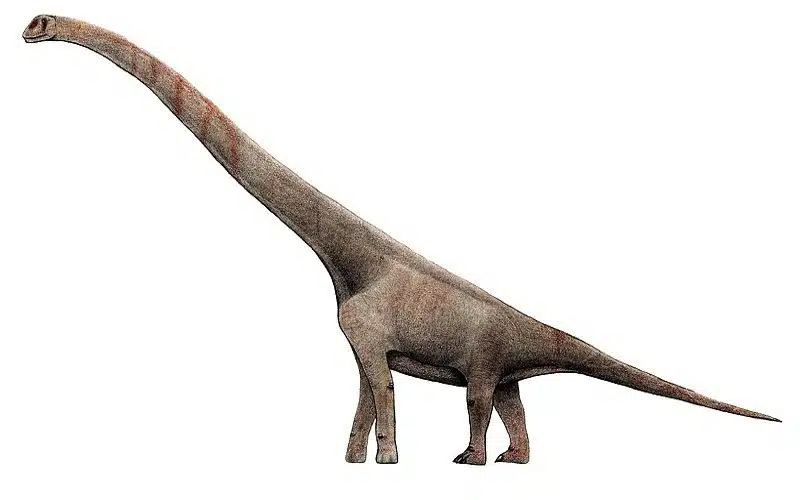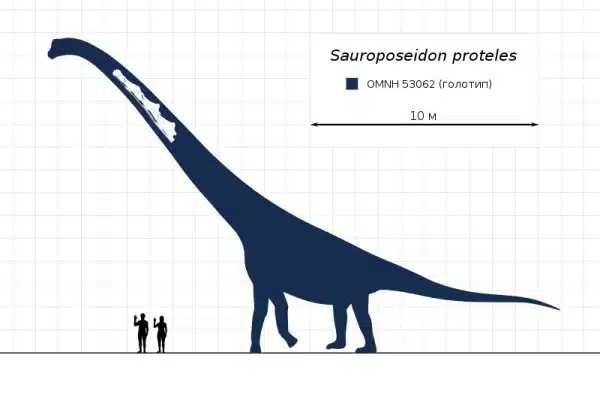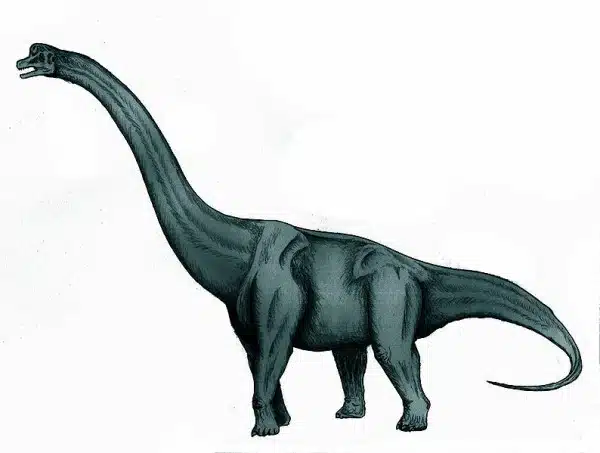Let’s embark on a journey through time to an era when giants roamed the Earth. Among these colossal beings was Sauroposeidon, something that evokes images of ancient mythologies and untamed landscapes. This magnificent creature, whose name translates to ‘Lizard of Poseidon’, was a true marvel of the Early Cretaceous Period. Its discovery not only expanded our understanding of the dinosaur world but also sparked a sense of wonder about these long-gone giants.
Sauroposeidon Key Facts
| Keyword | Fact |
|---|---|
| Pronunciation | sore-oh-po-SIGH-dun |
| Meaning of name | Lizard of Poseidon |
| Group | Sauropod |
| Type Species | Sauroposeidon proteles |
| Diet | Herbivore |
| When it Lived | 113.0 to 100.5 MYA |
| Period | Early Cretaceous |
| Epoch | Between the Aptian and Albian |
| Length | 89.0 112.0 feet |
| Height | 20.0 to 23.0 at shoulder |
| Weight | 44.0 to 66.0 tons |
| Mobility | Moved on all four |
| First Discovery | 1994 by Bobby Cross |
| Described by | 2000 by Matt Wedel |
| Holotype | OMNH 53062 |
| Location of first find | Antlers Formation, Oklahoma |
| Also found in | Arkansas, Texas, Wyoming |
Sauroposeidon Origins, Taxonomy and Timeline
This dinosaur’s name intriguingly combines the Greek ‘sauros’ (meaning lizard) with Poseidon, the Greek god of the sea and earthquakes. This aptly reflects the grandeur and power of this dinosaur. The ‘earthquake god’ aspect of its name is particularly fitting, considering the massive size and impact this creature would have had on its environment. This nomenclature not only captures the essence of its formidable presence but also ties it to ancient mythologies, bridging the gap between the realms of science and legend.

In terms of taxonomy, Sauroposeidon is a member of the Brachiosaurid family, closely related to other well-known Sauropods like Brachiosaurus and Giraffatitan. These relatives share several characteristics, including long necks and a massive body size. The discovery and subsequent classification of this unique herbivore have significantly enriched our understanding of sauropod diversity and evolution during the Early Cretaceous Period.
This genus of Sauropod dinosaur is known from several incomplete specimens, including a bone bed and fossilized trackways discovered across the United States. These finds provide a glimpse into the life of a dinosaur that once dominated vast landscapes of North America. The fossils date back to the late Early Cretaceous Period. This time frame was crucial for Sauropods in North America, marked by a significant decrease in their diversity. Sauroposeidon stands as the last known North American sauropod before a 40-million-year gap in their presence on the continent, a hiatus that ended with the arrival of Alamosaurus during the Maastrichtian Stage.
Discovery & Fossil Evidence of Sauroposeidon
The journey to uncovering Sauroposeidon began with an unexpected discovery in rural Oklahoma, near the Texas border. In May 1994, dog trainer Bobby Cross stumbled upon four neck vertebrae in a claystone outcrop at the Antlers Formation in Atoka County. These fossils dated back about 110.0 million years to the Early Cretaceous Period and were initially mistaken for tree trunks due to their enormous size and state of preservation. In fact, these vertebrae are the longest of their kind known in dinosaurs. It wasn’t until 1999 that graduate student Matt Wedel, under the guidance of Dr. Richard Cifelli, recognized their true significance. This led to a press release in October 1999 and an official publication in the Journal of Vertebrate Paleontology in March 2000, introducing the world to Sauroposeidon proteles, the holotype OMNH 53062.
In 2012, a significant reclassification occurred. Numerous sauropod remains, previously known under different names and found in the Paluxy River area of Texas, were reclassified as belonging to the Sauroposeidon genus. These included fossils from a bonebed discovered by University of Texas at Austin students in the 1980s in Hood County, Texas. Excavations by various teams revealed a rich collection of Sauropod bones, including a partial skull, neck, back, and tail vertebrae, and most limb and girdle bones. This site, once a fluvial environment, also contained petrified logs. The reanalysis of these specimens, in light of additional Sauroposeidon remains, led paleontologists to conclude that Paluxysaurus, previously thought to be a distinct genus based on vertebral details and morphological differences, was in fact the same animal as Sauroposeidon.

Sauroposeidon Size and Description
It comes as no surprise that this towering Sauropod was one of the largest dinosaurs of its time–but how much larger was it? Let’s take a closer look at what sets this dinosaur apart from the rest.
Size and Weight of Type Species

The size of this dinosaur is primarily estimated by comparing its vertebrae to those of Giraffatitan brancai, the most complete Brachiosaur known, which is housed in Berlin’s Natural History Museum. Based on these comparisons, its neck length is estimated to be between 37.0 to 39.0 feet, surpassing Giraffatitan’s 30-foot neck. Its shoulder height is estimated to be between 20.0 to 23.0 feet, positioning it as a towering figure in its habitat.
Estimates of its total length range from 89.0 to 112.0 feet. When it comes to weight, it is estimated to have weighed between 44.0 to 66.0 tons. Despite its larger neck vertebrae, which are 25-33% longer than those of Giraffatitan, its overall body diameter was only 10-15% larger. This suggests that while it had a larger body than Giraffatitan, its body was smaller in proportion to its neck. This results in a lower overall weight compared to a scaled-up Giraffatitan, which might have weighed between 40.0 to 44.0 tons. This balance in body proportions highlights the unique evolutionary adaptations of Sauroposeidon and makes it one of the most fascinating Sauropods of its time.
The Dinosaur in Detail
This dinosaur was characterized by its extraordinarily elongated neck. The original find included four articulated mid-cervical vertebrae, with the largest vertebra measuring an impressive 4.6 feet in length, making it the longest Sauropod neck vertebra on record. The vertebrae were honeycombed with tiny air cells and were remarkably thin, akin to the bones of a chicken or an ostrich. This adaptation made the neck lighter and easier to lift. Additionally, the cervical ribs were notably long, with the longest rib measuring about 11.2 feet.
While it may not hold the title of largest dinosaur, its long neck may very well grant it the title of tallest dinosaur. It was probably capable of lifting its head nearly 60 feet off the ground. For perspective, Giraffatitan could raise its head to about 44.0 feet.
Sauroposeidon in its Natural Habitat

This giant thrived along the shores of the ancient Gulf of Mexico. Now known as Oklahoma, this area was part of a vast river delta akin to the modern Mississippi delta during the Early Cretaceous. The Antlers Formation extends from southwest Arkansas through southeastern Oklahoma to northeastern Texas and preserves this ancient landscape. Although not precisely dated through radiometric methods, scientists have inferred from biostratigraphic data and similarities with Texas’s Trinity Group that this formation dates back to the Aptian and Albian stages of the Early Cretaceous, around 110.0 million years ago.
At the time, this was a sprawling floodplain that drained into a shallow inland sea. This environment would soon evolve into the Western Interior Seaway that split North America into two continents during the Late Cretaceous. The world of Sauroposeidon was characterized by tropical or sub-tropical forests, river deltas, coastal swamps, bayous, and lagoons–bearing a resemblance to the landscapes of modern-day Louisiana. This rich and varied ecosystem provided an ideal setting for this herbivore to flourish.
Contemporary Dinosaurs
In the ancient world where Sauroposeidon reigned, its towering presence was a marvel. This gentle giant, with its long neck reaching towards the sky, browsed on high tree canopies. This dining habit that kept it mostly clear of direct competition for food. However, in the same realm, Acrocanthosaurus, a predator of formidable size, roamed the land. While Sauroposeidon was larger and dwarfed Acrocanthosaurus by a significant margin, the latter’s fierce nature and sharp teeth made it a creature to be wary of. Their interactions were likely rare but must have been tense as Acrocanthosaurus might have eyed juvenile Sauroposeidons, contemplating a challenging yet rewarding hunt.
Amidst these giants, Deinonychus–a smaller but no less significant player–darted through the underbrush. These agile hunters were roughly the size of a modern horse and likely too small to pose a direct threat to adult Sauroposeidons. However, their presence added a layer of complexity to the ecosystem. Deinonychus might have opportunistically preyed on their young. Their interactions, though speculative, paint a picture of a dynamic environment where size and speed played crucial roles in survival.
Tenontosaurus, a medium-sized herbivore, shared the landscape with this giant. Smaller than Sauroposeidon but larger than Deinonychus, Tenontosaurus could have been a common prey for Acrocanthosaurus. This herbivore’s existence might have indirectly influenced Sauroposeidon’s life. Their presence could attract more predators to the area and increased the overall tension and vigilance required for survival. The interplay of these diverse species around Sauroposeidon showcases a vibrant and complex ecosystem where each creature, from the towering Sauroposeidon to the swift Deinonychus, played a pivotal role in the dance of prehistoric life.
Frequently Asked Questions
It lived during the Early Cretaceous Period, approximately 113.0 to 100.5 million years ago.
As an herbivore, it fed on the high vegetation of its lush, forested environment.
Bobby Cross discovered these fossils in 1994 in Oklahoma, and it was later described by Matt Wedel in 2000.
Fossils have been found in Oklahoma, Arkansas, Texas, and Wyoming.
Its extraordinary height, long neck, and status as one of the tallest and heaviest dinosaurs set it apart.
While definitive evidence is lacking, it’s likely that Sauroposeidon, like many sauropods, lived in social groups or herds.
Sources
The information in this article is based on various sources, drawing on scientific research, fossil evidence, and expert analysis. The aim is to provide a comprehensive and accurate overview of Sauroposeidon. However, please be aware that our understanding of dinosaurs and their world is constantly evolving as new discoveries are made.
- https://www.geol.umd.edu/~tholtz/dinoappendix/HoltzappendixWinter2011.pdf
- https://web.archive.org/web/20070621122509/https://www.sauroposeidon.net/Wedel-Cifelli_2005_native-giant.pdf
- https://web.archive.org/web/20200626075134/https://pdfs.semanticscholar.org/9efe/8db6eb32247f90a760110d5a9695977fb761.pdf
- https://palaeo-electronica.org/2007_2/00063/
Article last fact-checked: Joey Arboleda, 12-14-2023
Featured Image Credit: Levi bernardo, CC BY-SA 3.0, via Wikimedia Commons
